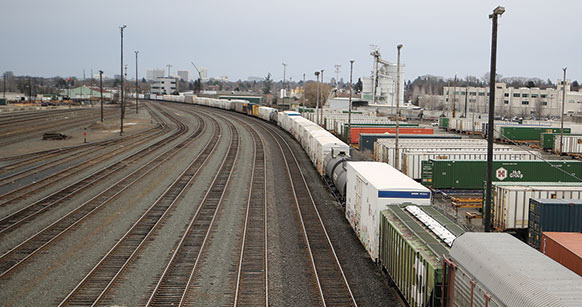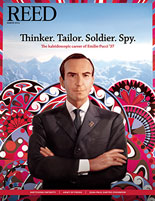
IRIS login | Reed College home Volume 93, No. 1: March 2014
Rail Yard Blues

Photo by Tom Humphrey
Senior thesis tracks pollution at Portland rail yard.
By Randall S. Barton

Environmental studies/chemistry major Alan Tuan ’14 monitors “black carbon” emissions for his thesis. Photo by Matt D'Annunzio
The railcars rumble, the brakes squeal, and the couplings clash like distant gunfire. Generations of Reed students have known the Brooklyn Rail Yard as a gritty source of inspiration for the blues, a jumping-on point for freight trains, or simply an offbeat destination for a midnight ramble.
For chemistry/environmental studies major Alan Tuan ’14, however, the yard is more than that—it’s the focus of his thesis. Prompted by concerns from nearby residents, Alan is tracking pollution from the rail yard, with a particular eye on particulates—microscopic bits of soot and ash that, in sufficient concentrations, can have devastating impact on human health.
The science
While diesel engines emit relatively low quantities of carbon monoxide and hydrocarbons, they spew lots of fine and ultra-fine particulates. For example, while heavy-duty diesels make up only 7% of all motor vehicles, they emit nearly 65% of the particulates.
Just a fraction of the width of a human hair, fine particulates have a surface area that absorbs toxic organics and can pass like gas through the lungs, transporting absorbed toxins directly into the bloodstream. Researchers estimate that their effect on human health may be much greater than other combustion-related pollutants such as nitrogen oxides (NOX), hydrocarbons, and carbon monoxide (CO). Diesel particulates have been associated with a number of health effects including premature mortality, aggravation of respiratory and cardiovascular disease, chronic bronchitis, and asthma.
Railroad activity is a relatively small contributor to the overall burden, but pollution near rail yards can be significant.
Additional environmental impacts include climate change resulting from so-called black carbon— the soot resulting from the incomplete combustion of fossil fuels. Sixty percent of black carbon emissions in the United States are from diesel engines.
The air we breathe
When it was first established in the 1860s, the rail yard was relatively isolated. But over the years, the neighborhoods of Eastmoreland, Westmoreland, and Sellwood sprouted up around it, stoking tension as residents complained about noise and diesel fumes from the yard.
In 1956, residents won an injunction against Southern Pacific, forcing it to put restrictions on both emissions and its hours of operation. The case sat dormant for 43 years until 2003, when the Eastmoreland Neighborhood Association (ENA) and the Sellwood-Moreland Improvement League (SMILE) accused the railroad (by merger now the Union Pacific) of violating the injunction.
In 2012, Union Pacific agreed to switch out older locomotives at the yard for newer ones that should emit less pollution, and fit certain cranes and packers with diesel particulate filters. But the neighbors were left with a nagging anxiety—would these changes make a real difference? How much pollution is the yard emitting into the air they breathe every day? And how could they ever keep track?
Then the president of the ENA, Robert McCullough ’72, had a brainwave.
An independent energy consultant, Robert often employs Reedies at his offi-ces in Eastmoreland. He approached Prof. Juliane Fry [chemistry 2008–] with a proposal—why not collect data on air quality before and after Union Pacific upgraded the locomotives in the yard?
Fry quickly sensed the idea’s potential. “Scientifically it’s great to be able to study something where there’s supposed to be a clear change,” she says.
Before long, she was working on the problem with Alan, who became interested in studying black carbon for his thesis after Fry discussed its importance in an environmental studies junior seminar. It was an ideal thesis topic because it combined chemistry with economic and political implications.
In fall 2013, Alan and Ben Ayres, a postdoctoral researcher in the Fry lab, set up a cluster of instruments at a Reed warehouse on Southeast 28th Avenue, roughly half a mile from the heart of the yard. One measures wind direction. Others monitor CO2 and NOX. But the star of the show is an aethalometer, which measures black carbon—the soot aerosol produced by diesel engines. (The aethalometer was purchased with the help of the two neighborhood associations.)
Alan says that a general baseline chart will establish the background concentrations of black carbon, which has many sources. “Ideally we would see a spike in black carbon whenever a train goes past our instruments,” he says, “along with a corresponding spike in CO2 and NOX.”
Of all the things he’s measuring, Alan says that black carbon is the least studied and a new area of focus in environmental chemistry. As Union Pacific was required to switch to more efficient locomotives by the end of 2013, Alan is eager to examine the data since winter break to see if there’s been a change in emission patterns.
“If there’s a reduction,” he says, “that’s a sign that maybe they switched to more efficient locomotives. If there’s no change, well maybe they haven’t done it yet or we can’t see it. If there’s an increase, maybe they’re using more trains since they’ve switched to the more efficient engines. We’re always curious about those patterns, and if we see a change in them, we want to figure out why.”
Alan hopes to set up additional sampling equipment at the Eastmoreland Golf Course, which would get him closer to the tracks.
In the next few months he plans to launch a website and share his findings with the public. Prof. Noelwah Netusil [economics 1990–] will help him with the economic analysis, and Prof. Chris Koski [political science 2011–] will assist with the policy perspective.
The tension over the Brooklyn Rail Yard is unlikely to abate any time soon. “In the long term, this is a ridiculous place to put a rail yard,” Robert says. But in order to figure out the costs and benefits of the various options—upgrading the equipment, reducing rail traffic, or even relocating the yard—Alan’s project to monitor the air quality is a crucial step.

LATEST COMMENTS
steve-jobs-1976 I knew Steve Jobs when he was on the second floor of Quincy. (Fall...
Utnapishtim - 2 weeks ago
Prof. Mason Drukman [political science 1964–70] This is gold, pure gold. God bless, Prof. Drukman.
puredog - 1 month ago
virginia-davis-1965 Such a good friend & compatriot in the day of Satyricon...
czarchasm - 4 months ago
John Peara Baba 1990 John died of a broken heart from losing his mom and then his...
kodachrome - 7 months ago
Carol Sawyer 1962 Who wrote this obit? I'm writing something about Carol Sawyer...
MsLaurie Pepper - 8 months ago
William W. Wissman MAT 1969 ...and THREE sisters. Sabra, the oldest, Mary, the middle, and...
riclf - 10 months ago